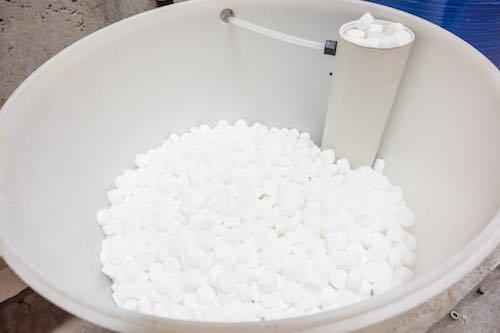How Water Softening Systems Work
Water Softeners in Southern MD

Conventional water-softening systems eliminate magnesium (Mg) and calcium (Ca) ions from hard water, which are instead replaced with sodium (Na) ions. This is because magnesium and calcium ions prevent household detergents and soaps from reacting with impurities whereas sodium doesn’t block the reaction. As a result, detergents are capable of removing oils and dirt from your dishes and clothing in a more effective manner. Soaps also provide your skin a ‘slippery’ texture when you take a shower. Most water softening system manufacturers recommend reducing the quantity of detergents and soaps you use once you’ve installed the system
Water softening units are usually installed right in your household plumbing system right where your house receives its water supply, thus softening the water utilized for washing and drinking purposes but not the water used for irrigation. This unit contains several cu ft. of porous plastic resin completely covered with molecules, which attract & bind themselves to the positive ions present in the water. Usually, Na+ ions are used for coating the resin. However, when the water flows over this resin area to the washer or sink, the Mg+ and Ca+ ions in the hard water start sticking to this resin. Na+ ions are then released for ensuring that the electrical charge existing on the resin remains in a state of balance. Na+ ions are gradually released into the water, causing the resin to become saturated with magnesium and calcium ions. Every once in a while, the unit rinses the resin with a concentrated salt water solution (NaCl) to renew it, usually during the night. The saltwater’s high sodium ion concentration displaces the magnesium and calcium ions in the resin, which leads to the resin becoming covered in sodium ions. The saltwater then rinses the water and flushes away the magnesium and calcium ions, which allows the system to resume its operations. (It is crucial to add sodium chloride salt regularly to your softener unit for preparing the salty water needed for rinsing purposes)
Each cu ft. of resin is capable of removing magnesium and calcium ions from around 3200 gallons of hard water – defined by the WQA to be water that has a hardness of more than 10 grains per gallon. This process adds around 750 mg of Na to every gallon of water. In case you’re worried about excessive sodium intake, you can use resins that utilize potassium. However, potassium chloride salts are more expensive compared to regular sodium chloride salts.



